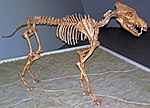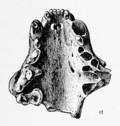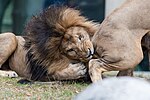Carnassials are paired upper and lower teeth modified in such a way as to allow enlarged and often self-sharpening edges to pass by each other in a shearing...
15 KB (1,622 words) - 09:33, 18 September 2024
upper carnassial) that is only used for cutting. They use their molars for grinding except for the lower first molar m1 (the lower carnassial) that has...
42 KB (4,171 words) - 23:06, 24 September 2024
presence of the carnassial teeth, but the nature of the carnassial teeth is different between the two groups. In carnivorans the carnassials are positioned...
46 KB (4,423 words) - 22:39, 3 October 2024
borophagines, with both groups having a bicuspid (two points) on the lower carnassial talonid, which gives this tooth an additional ability in mastication....
46 KB (5,063 words) - 21:00, 5 October 2024
(African wild dog). The crushing role of the post-carnassial molars is reduced. The lower carnassial (m1) of Speothos lacks the entoconid, creating a trenchant...
3 KB (333 words) - 03:09, 24 June 2023
rostrums (snouts) than caniforms, fewer teeth, and more specialized carnassials. Feliforms tend to be more carnivorous and are generally ambush hunters...
22 KB (2,185 words) - 12:35, 14 October 2024
of dull, triangular carnassial teeth meant for grinding food. Hypercarnivores, however, have conical teeth and sharp carnassials meant for slashing, and...
222 KB (23,103 words) - 19:04, 29 September 2024
transversely set, much smaller than the upper carnassial, and much wider than it is long, so that the upper carnassial is nearly at the posterior end of the upper...
11 KB (878 words) - 00:02, 17 May 2024
share with the Carnivora, and many other predatory mammal clades, the carnassial shear, a scissors-like modification of upper and lower cheek teeth that...
31 KB (3,298 words) - 05:44, 19 September 2024
upper and lower carnassial teeth of the Italian wolf are close to those of C. l. maximus. Fluctuations in the size of C. lupus carnassial teeth correlate...
49 KB (5,499 words) - 00:43, 9 September 2024
south-central China. The skulls of the five type specimens had shorter carnassials and molars than tigers from India, a smaller cranium, orbits set closer...
149 KB (16,417 words) - 01:11, 17 October 2024
of canids are buttressed behind the carnassial teeth to enable the animals to crack bones with their post-carnassial teeth (molars M2 and M3). A study found...
108 KB (11,677 words) - 00:29, 9 October 2024
have small vertebrae. The premolar and first molar together compose the carnassial pair on each side of the mouth, which efficiently shears meat into small...
161 KB (16,541 words) - 14:43, 16 October 2024
size in the extinct saber-toothed species. The lower carnassial is smaller than the upper carnassial and has a crown with two compressed blade-like pointed...
49 KB (3,882 words) - 19:35, 7 October 2024
conical, pointed, thick and stress resistant, and presence of the carnassial teeth. Carnassials are feature that allows distinguishing the Carnivoramorpha,...
24 KB (1,853 words) - 22:39, 3 October 2024
common feature for members of this clade is the presence of the carnassial teeth. The carnassial teeth of the Carnivoramorpha are upper premolar P4 and lower...
14 KB (1,214 words) - 00:13, 17 September 2024
teeth, and it has evolved for the consumption of flesh. Dogs use their carnassial teeth to cut food into bite-sized chunks, more especially meat. Dogs'...
184 KB (17,386 words) - 01:01, 17 October 2024
most other members of the Carnivora, bears have relatively undeveloped carnassial teeth, and their teeth are adapted for a diet that includes a significant...
106 KB (10,686 words) - 20:43, 28 September 2024
Inferior surface. Unerupted permanent teeth underlie the deciduous teeth. Carnassial Incisor Molar Premolar This article incorporates text in the public domain...
11 KB (1,334 words) - 05:21, 4 September 2024
largest subspecies; it has rather pale fur and bears large molars and carnassials. The Great Plains from Alberta, Manitoba, and Saskatchewan south to New...
155 KB (16,000 words) - 10:31, 15 October 2024
bear has large pointed canines for killing prey, and self-sharpening carnassial teeth at rear for cutting flesh with a scissor-like action Large compound...
109 KB (11,578 words) - 08:25, 29 September 2024
have six extra molars, totalling in 48 teeth.) Foxes have pronounced carnassial pairs, which is characteristic of a carnivore. These pairs consist of...
42 KB (4,274 words) - 16:35, 8 October 2024
with a three-cusp anatomy which nevertheless functioned similarly to carnassials. Mesocarnivore Ullrey, Duane E. "Nutrient". Encyclopedia of Animal Science...
20 KB (2,008 words) - 22:29, 15 October 2024
canines (pigs and walruses), the adaptation of molars into flesh-shearing carnassials in Carnivora, and others. The extant mammalian infraclasses each have...
14 KB (1,832 words) - 18:51, 27 May 2024
probably larger than female sea minks. The sea mink's wider carnassial teeth and blunter carnassial blades suggest that they crushed hard shells more often...
26 KB (3,044 words) - 18:13, 10 May 2024
over many years to better fit their diets. Carnivores possess canine, carnassial, and molar teeth, while herbivores are equipped with incisor teeth and...
14 KB (1,635 words) - 01:48, 23 September 2024
thus forcing them to operate in teams. Spotted hyenas evolved sharp carnassials behind their crushing premolars, therefore they did not need to wait...
66 KB (6,307 words) - 07:55, 8 October 2024
were less developed than modern carnivorans. They had carnivoran-type carnassials, but lacked fully ossified auditory bullae (rounded protrusions). Miacidae...
11 KB (895 words) - 02:27, 9 September 2024
308 and 1,554 kg (2,884 and 3,426 lb), based on equations derived from carnassial length of hyaenodonts and m3 length of felids respectively, which would...
5 KB (462 words) - 06:28, 30 September 2024
blade-like teeth especially adapted for slicing and chopping called carnassials. A general term for such blade-like teeth is secodont or plagiaulacoid...
18 KB (1,919 words) - 00:16, 29 April 2024






























